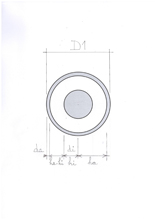The improvement of the prediction of the acoustic and aeraulic performance of cylindrical silencers (with central pod) is the subject of Research and Development (R&D) works sinces decades.
Indeed, the cylindrical silencers with central pod are of common use when it is a question of limiting the propagation of noise in a network of pipes or ducts themselves of circular geometry.
This is notably the case for industrial processes and, in the building sector, for all or part of the ventilation / air-conditioning systems (which often gives prominence to the use of spiral ducts) :
- the upstream and downstream of a helical fan are in essence with a circular geometry to allow the rotation of the blades: in different contexts, considering silencers with rectangular section is not ideal, because it complicates the design, the construction and increases the size of the soundproofing devices (and their cost) in relation to the need to implement connection parts
- the ducts of circular cross section of small and medium diameter may have, with equal thickness of constituent material, performances superior to those of rectangular ducts of the same frontal area, in particular for the low frequencies, which may be of interest if the limitation of the sound transmission through the walls of the air network is a concern
The addition of a central splitter (pod) makes it possible to increase the acoustic performance of a cylindrical silencer, the total pressure loss being often in a position of being kept sufficiently low if the width of the air channels is appropriately selected depending to the flow rate.
As an extension of what has been reported on the occasion of a previous post (here), ITS has developped and improvement of the prediction of the acoustic and aeraulic performance of cylindrical silencers (with central splitter / pod): the calculations are now possible for an absorbing filling that can be different (not only in thickness, but also in nature: by varying the porous medium, cloth, perforated protection) on the one hand for the central pod / splitter or and on the other hand for the peripheral absorbent lining.
At the current stage, if the fluid velocity is (of course) taken into account for the evaluation of the total pressure loss and of the self-noise (due to the flow) of the silencer, it is not (yet) accounted as far as the propagation of sound inside airways and lining is concerned (the latter supposed to be locally reacting, at the current level of implementation): the best precision of the calculations is therefore (for now) obtained for low Mach number values, which is ideal for HVAC (Heating, Ventilation, Air Conditioning) installations.
The comparison of the simulation results with bibliographic data (measurement results, calculation results by others, ...) showed, for several combinations of parameters influencing the dimensioning (not only the length and the transverse dimensions da, ha-hi and 2hi in the diagram below for mounting C1A), an agreement that was analysed as being sufficient to allow the validation of the tool for predicting the acoustic and aeraulic performance of cylindrical silencers with central pod that is Terminal 4 of Module 1 of the acoustics calculation software SILDIS®.
|
Cylindrical silencer with central pod with diameter 2hi, with peripheral absorbing lining with thickness da and with airway ha-hi |
